Lustrum edition Semiconductor Packaging University Program
September 5, 2024 – On Tuesday September 3, the fifth edition of the Semiconductor Packaging University Program started at the Noviotech Campus in Nijmegen. 29 people are taking part in the lustrum edition of the program. Over the next seven weeks, they will be introduced to the semiconductor industry and delve deep into the final step of chip manufacturing: chip packaging.
Mix of students and semicon staff
As in the four previous editions, the participants consist of a mix of students and professionals. Joop Bruines, education consultant at CITC and also working at HAN University of Applied Sciences (HAN), is happy with yet again a full classroom: “We have a good mix of people. In addition to industry participants from semiconductor companies such as ITEC, NXP, Sempro and iPronics, there are fifteen bachelor students from HAN and similar Dutch universities of applied sciences and from Rhein-Whaal Hochschule in Cleves. And there is one PhD student from University of Twente.”
Just like last year, there is a group of students from Panama who are following the program online. “Last year, four professors from Universidad Tecnológica de Panamá followed the theoretical program online and then came to the Netherlands for a week of practical training. Apparently, this was a success because four other professors are following the program this year. And they will also come over to the Netherlands later this year. I’m already looking forward to meeting them”.
Tailor-made program
CITC and HAN developed this program tailored to the specific needs of semiconductor companies. The program focuses on the design and manufacture of semiconductor packages and the associated assembly, reliability, and testing techniques. For the bachelor students the course is part of a full minor including a practical assignment which is carried out at either a semiconductor company or CITC.
Kick-off
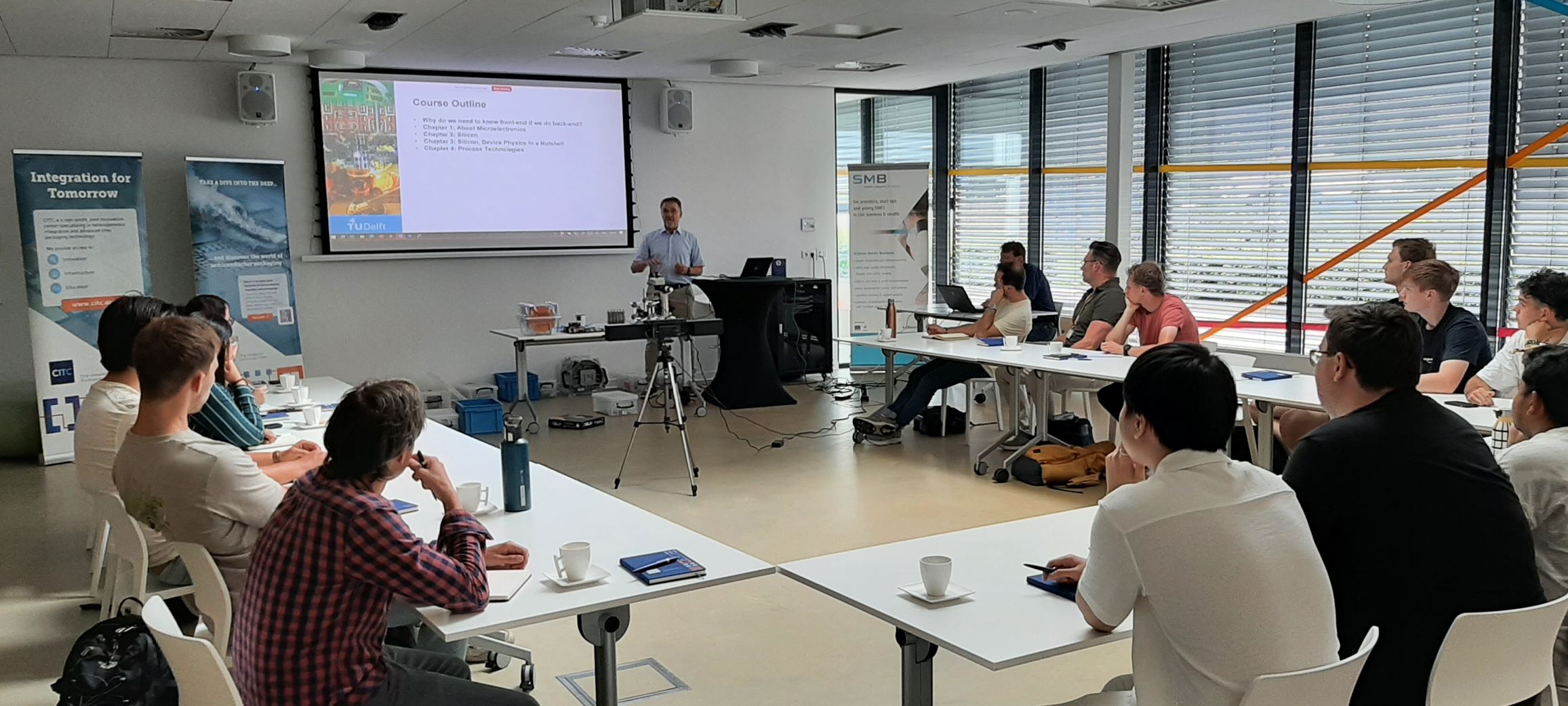
Students listen to Henk van Zeijl (TU Delft) about semiconductors front end
In his introductory speech at the kick-off, Bruines emphasized the importance of chips in everyday life and the need for well-trained people in this field. Then he gave the floor to Henk van Zeijl from TU Delft for the first lecture of the program about the semiconductor front end.
Van Zeijl had brought along a large number of samples to support his story. The students were then able to delve into topics such as bandgap, Moore’s law, p-n junction, oxidation and disposition, and the mechanical and electrical properties of silicon.
Interested in following the next edition of this program? Check out the program information or contact us.
PRESS RELEASE | Nijmegen, the Netherlands | August 29, 2024
Chip Integration Technology Center (CITC) today announced the appointment of Toni Versluijs as the new chairman of its Supervisory Board. Versluijs will serve as the incoming chairman from September through December. Effective January 1, 2025, he will take over the responsibilities from chairman Roel Fonville who is retiring.
Versluijs has an extensive background of more than 25 years in the semiconductor industry, of which more than 15 years in general and executive management roles. Prior to this appointment, he worked for NXP, where he led the In-Vehicle Networking product line and was NXP Nijmegen site director and statutory director of NXP Netherlands. Most recently, he led the Business Group MOS at Nexperia, served as statutory director for Nexperia in the UK and was part of the company’s global executive leadership team.
He explains his choice for CITC: “I look forward to using my many years of experience in the semiconductor industry to contribute to the success of CITC in Nijmegen. Nijmegen is a location with a long heritage in semiconductor packages that have changed the world. CITC is a unique venture and has a unique position between private parties, the academic world and knowledge institutes.”
CITC is a smaller and different kind of organization than his previous employers, but Versluijs sees the potential: “CITC has attracted quite some talent in recent years, built partnerships and initiated new developments. In short: it has laid the foundation for growth, and it will flourish in the coming years. I am convinced that it has the potential to change the world of semiconductor packaging again”.
The current chairman of the CITC Supervisory Board, Roel Fonville, adds: “The Supervisory Board is very pleased to welcome Toni Versluijs to our midst. His personality and broad experience in the industry and in the Nijmegen region will help the Board to fulfill its role in securing the continued development of the organization.”
– ENDS –
About CITC
Chip Integration Technology Center (CITC) is a non-profit, joint innovation center specializing in heterogeneous integration and advanced chip packaging technology. CITC has created an effective ecosystem in which companies, research and educational institutes work on bridging the gap between academics and industry. CITC’s contribution to the ecosystem is to provide access to innovation, infrastructure, and education. CITC was founded in 2019 with strategic partners TNO and Delft University of Technology and is supported by local and regional governments.
www.citc.org
Contact
Christian Ketelaars, Communications Manager
E christian.ketelaars@citc.org
M +31 (0)6 48 15 42 92
June 25, 2024 – On June 21, CITC and partner Sempro paid a return visit to the Technnasium students of Mondial College in Nijmegen. In April, 90 Mondial students visited CITC, Sempro and ITEC to learn more about chip production, packaging and all research & development efforts involved. The purpose of their visit was to gather enough input to create a chip exhibit that could be used at the Nijmeegse Techniekdag (Nijmegen Technology Day). During the return visit, the exhibits were assessed by CITC and Sempro.
Children design for children
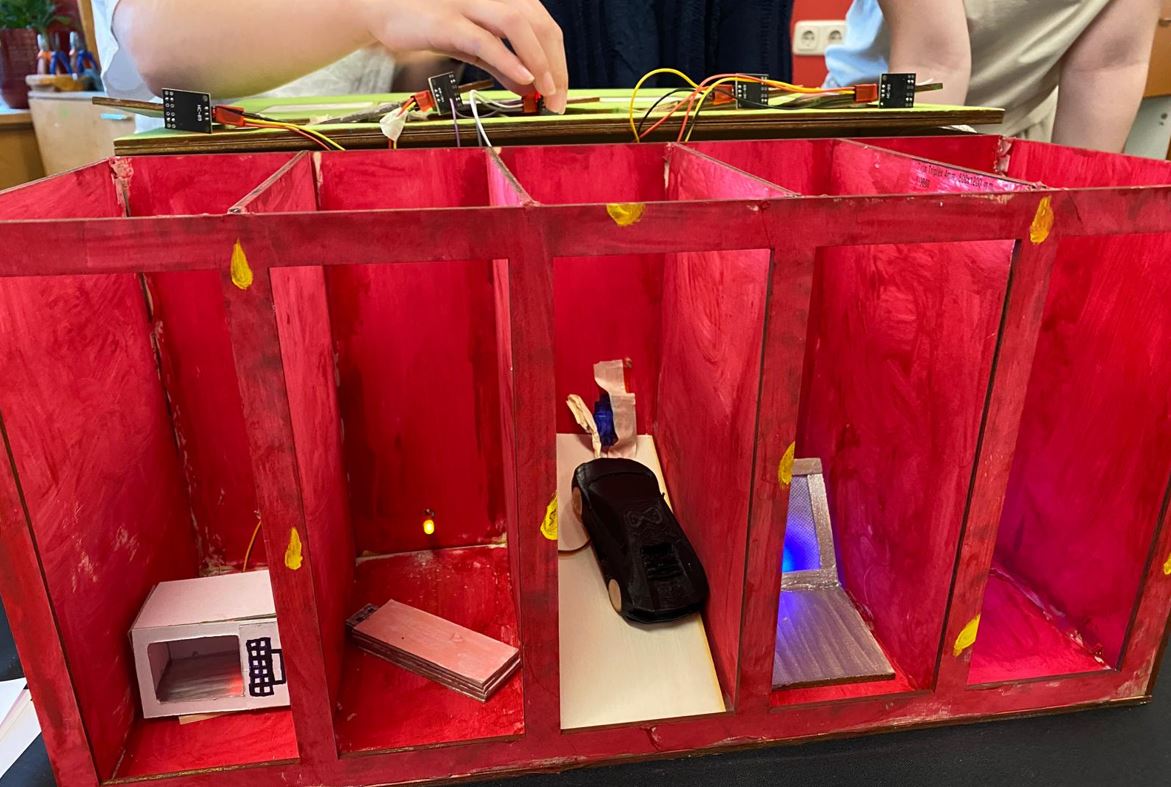 After the company visits, the students had eight weeks to process what they learned, collect background information and design and create an exhibit. Every year, more than 4,000 people (mostly children aged 8-12 years and their parents) visit the Techniekdag to become acquainted with all kinds of technical professions. If you want to distinguish yourself as a company during the day, you need an attractive booth with exhibits that appeal to a young audience. And who knows better what works than children in the same age group? Sempro therefore challenged the students to create an exhibit that stands out in a crowd and is factually correct and – preferably – interactive.
After the company visits, the students had eight weeks to process what they learned, collect background information and design and create an exhibit. Every year, more than 4,000 people (mostly children aged 8-12 years and their parents) visit the Techniekdag to become acquainted with all kinds of technical professions. If you want to distinguish yourself as a company during the day, you need an attractive booth with exhibits that appeal to a young audience. And who knows better what works than children in the same age group? Sempro therefore challenged the students to create an exhibit that stands out in a crowd and is factually correct and – preferably – interactive.
Well-thought-out exhibits
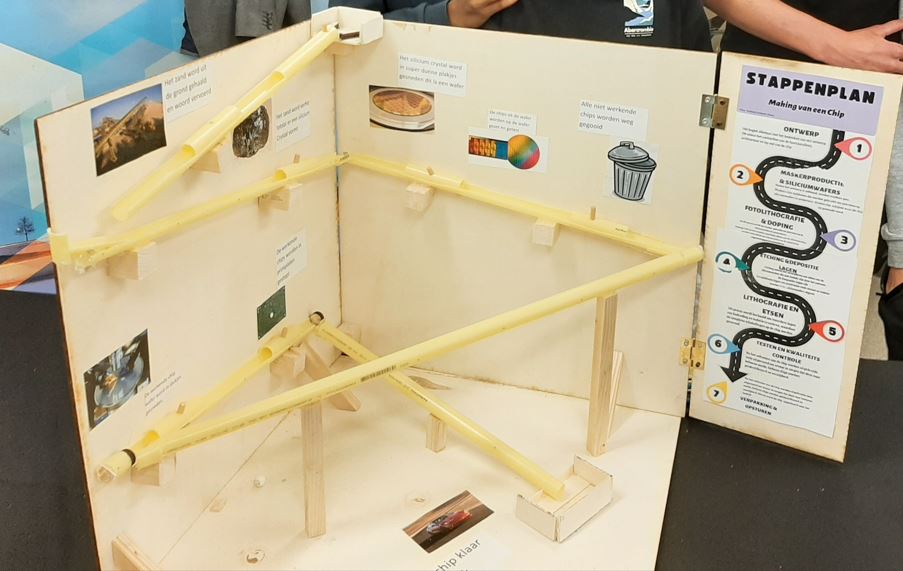 On June 21, all students had to present their exhibits to a three-person jury that focused on their respective values:
On June 21, all students had to present their exhibits to a three-person jury that focused on their respective values:
- Technical quality – assessed by Ewald Peters, CEO at Sempro
- Educational value – assessed by Nathan van den Dool, program manager education at CITC
- Communicative attractiveness and clarity – assessed by Christian Ketelaars, communications manager at CITC
The jury certainly got a run for their money. In three sessions of eight presentations each, they not only had to judge each exhibit but also declare a winning team. This was not an easy task as most students worked very hard, but each team had its own interpretation of the assignment. The eventual winners had one thing in common: they had not only created a well-thought-out technical exhibit but also one with great presentation value. The jury was pleased to see that there are many talented technical students and hoped to see them again in a few years as engineers or researchers.
Techniekdag
If you want to admire the winning student exhibits: the Nijmeegse Techniekdag will be held on September 21 at Technovium in Nijmegen.
March 12, 2024 – CITC is pleased to present its annual results infographic. Looking back at 2023, this was the year in which our main ambition was to grow. Growth in all kinds of areas: in the number of colleagues, in (lab) space, but especially in challenging innovative projects and in the number of students that we train and coach.
Innovation and infrastructure
2023 was important for CITC to continue building on the knowledge gained over the past four years and engage with the industry to understand what unique solutions we can offer, now and in the future. This led to the creation of our CITC Technology Roadmaps, which help us map out our future and strengthen our credentials.
A new program line was added: Advanced Additive Manufacturing Packaging. We aim to develop a new range of advanced packaging technologies together with our partner Holst Centre. These technologies offer very significant cost saving benefits and a much smaller environmental footprint; qualities that are desperately needed for Europe’s ambition to increase its sovereignty in the chip industry and the future of our planet.
Collaboration is central to our core activities. While further strengthening collaboration with existing partners, 2023 brought a new slate of collaborating partners, growing the CITC partnership diversity.
Peter Czurratis, Managing Director of PVA TePla, intensified cooperation with CITC in 2023:
“CITC is an upcoming and leading research center focused on new semiconductor wafer technologies and new trends in packaging and systems integration. Their cooperation with semiconductor companies and universities provides us with an excellent research platform for defining our future roadmap for the next generation of acoustic microscopes.”
Education
CITC works with educational institutions and industry to ensure that talent has ample opportunities to develop the skills in demand in the industry. Talent is not age-related and that is why we focus on all education levels: primary and secondary schools, vocational, bachelor and master courses, PDEng and PhD students and professionals.
We help spark enthusiasm for science, technology, engineering, and mathematics by giving children the opportunity to try things out for themselves during our events, excursions, and one-day internships.
Sarah van Dronkelaar, location manager of Weekendschool Nijmegen:
“My students were very enthusiastic during their visit to CITC. I heard one of them say: I actually wanted to study architecture, but I like chips much better!”
We offer plenty of opportunities for older students to participate in guest lectures, practical assignments, collaborative projects within the industry and internships. And finally, we offer formal education to bachelor students, PhD students and industry professionals in our accredited Semiconductor Packaging University Program, set up in collaboration with HAN University of Applied Sciences. In 2023, we trained a record number of 45 participants.
Bachelor student Mahad Saeed followed the Semiconductor Packaging University Program and is now doing his final internship project at CITC:
“Theory and practice in the minor were very well balanced. What I particularly liked was that we worked on real problems. And it was a plus that the industry professionals all had their specialties, which gave me good insight into what people in the industry are doing.”
In conclusion
Since our foundation 4.5 years ago, CITC has taken significant steps towards its ambition to become a leading partner in the fields of semiconductor and photonics packaging. Looking back at our objectives for 2023, we have indeed grown in almost all areas: we have hired more colleagues, participated in many innovative projects, and trained and supervised a record number of students. We hope and plan to continue this in the coming years. The only downside is that our desired growth in (lab)space has not yet been achieved. This is one of the challenges that must be addressed in 2024.
Downloads
CITC 2023 results infographic (EN)
CITC 2023 results infographic (NL)
January 31, 2024 – On January 21, Weekendschool Nijmegen visited CITC again. This year, CITC’s guest lecture was one of the four lessons in New Technology.
Joined forces with NXP and Nexperia
The two previous visits of Weekendschool in 2022 and 2023 consisted of a stand-alone guest lecture on chip packaging. This year, CITC joined forces with NXP and Nexperia. Together, the three organizations developed a series of lessons that formed a complete project.
At Nexperia, the students first learned about electricity. They then examined and demolished various electrical devices to discover how they are built and started designing their own robot. A week later, the students learned at NXP about electric circuits and microchips. They elaborated on their robot design and started programming their robot. In week three, CITC hosted the 45 first-year students. They learned about chip packaging, toured the labs, and continued their robot project.
Presenting robots
Twelve volunteers – from CITC, Nexperia and NXP – helped solve the last programming problems. The students who already tested and improved their robot started the final assembly and decoration. They finished the robots at their school in the last lesson of the series. On behalf of CITC, Ruben Pranger and Nathan van den Dool were invited to see what the end results had become. The students proudly presented their robots to them and all parents who were invited to see what their children had learned in the New Technology classes.
Access to education
Providing access to education is one of CITC’s core activities. By inspiring children at a young age for technology in general, and perhaps a technical education and profession in particular, we want to contribute to the future of the semiconductor industry in Europe.
Please feel free to contact our program manager education, Nathan van den Dool, if your school is also interested in a CITC guest lecture or company visit.
November 9, 2023 – Two more students have completed their internship at CITC: Matteo Delle Donne and Gerick de Kruijf. The two ROC Nijmegen students in Creative Technology created a chip packaging demo model for use at trade shows and conferences.
Complete redesign
In February, Matteo and Gerick took over this assignment from two fellow students. Gerick: “We know Ted and Nils quite well and they recommended CITC to us. So we continued their project, although we completely redesigned the model.” Both students were able to utilize their main qualities in this project. Matteo is a skilled draftsman who has worked on 2D and 3D drawings. Gerick, on the other hand, is good at coding, electrical engineering, soldering, and making calculations about how much power to use.
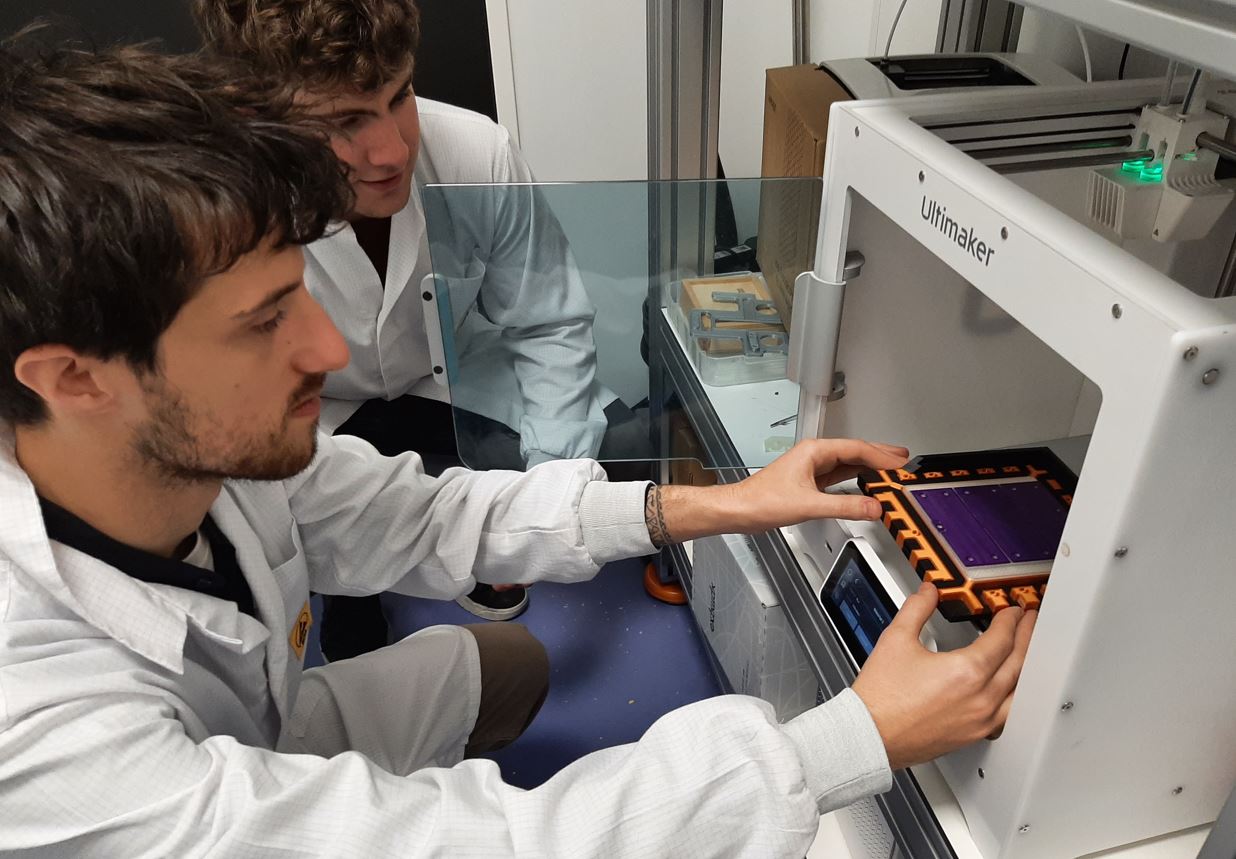
Moving lights
Together they worked on a chip packaging demo model for use at trade shows and conferences. Matteo explains their creation: “We took a MOSFAT (a voltage divider) as a starting point. The underlying idea is that the model shows the relationship between current and temperature. CITC has developed an adhesive that has a longer lifespan than usual, and we tried to visualize that with moving lights in different colors.” When asked whether they are happy with the end result, Matteo is enthusiastic, but Gerick admits that he would have done it differently now. “According to my father, that means that I have learned a lot during my internship.” The model is now ready and will premiere at SEMICON Europa from November 14-17.
Freedom to operate
Both students agree on how they experienced their time at CITC, a resounding ‘we liked it!’ “I really liked the freedom to operate. Perhaps that doesn’t work well for everyone, but I enjoyed it,” Matteo explains. Gerick adds: “It was great that we could actually try things out. We started designing a PCB and we were allowed to have test pieces made.” Despite the freedom there was obviously supervision. “We could always ask questions,” says Matteo.
When asked to characterize their CITC internship in three words, they choose freedom, friendly and innovative. Gerick: “We would definitely recommend CITC as an internship provider.” They are now both moving on to another internship. Matteo will most likely start work at a company that makes injection molds for the production of car parts. And Gerick is pursuing an internship in embedded systems. Normally, these are master internships, but he hopes to have a chance with his experience as vocational student.
Wanted: new students
Interested in an internship or graduation assignment at CITC? Check out the opportunities or send an open application.
October 30, 2023 – Reliability. According to our Ph.D. researcher Henry Antony Martin, this is an essential performance metric in realizing high-efficiency, high-power density devices. In his work, Henry mainly focuses on reliability monitoring and thermal management.
He explains: “Nowadays, we are very aware of environmental problems and the need for sustainability. This awareness has made energy-efficient systems, renewable energy technology, electric cars, and smart grids more important. To ensure that these systems work well and last long, reliability is the key. It’s the ultimate guarantee that the systems continue to work and perform as they should.”
Extensive lab infrastructure
Henry continues: “At CITC, we are committed to supporting the packaging community with our execution excellence in advanced semiconductor and photonic packaging innovation and assembly processes. With reliability testing, we gain quantitative insights into our packaged products and evaluate them to improve the packaging processes.”
CITC has an extensive laboratory infrastructure with equipment for reliability testing/monitoring methods, characterization, and advanced imaging techniques:
- Thermo-mechanical cycling lifetime testing
- Probe stations for PQFN
- Advanced imaging techniques
Thermo-mechanical cycling lifetime testing
Conducting accelerated lifetime tests for packaging components is essential in reliability engineering. The thermo-mechanical cycling lifetime (TMCL) testing framework allows CITC to rigorously evaluate the durability and long-term performance of micro and power electronic packaging components.
Henry: “Such accelerated TMCL testing is usually performed offline with packaged devices that are measured intermittently. However, we have the unique capability to conduct both offline and online condition monitoring during TMCL testing. Online monitoring of device condition includes characterizing electrical and thermal performance at different ambient temperatures to effectively evaluate package performance degradation.”
Probe stations for PQFN
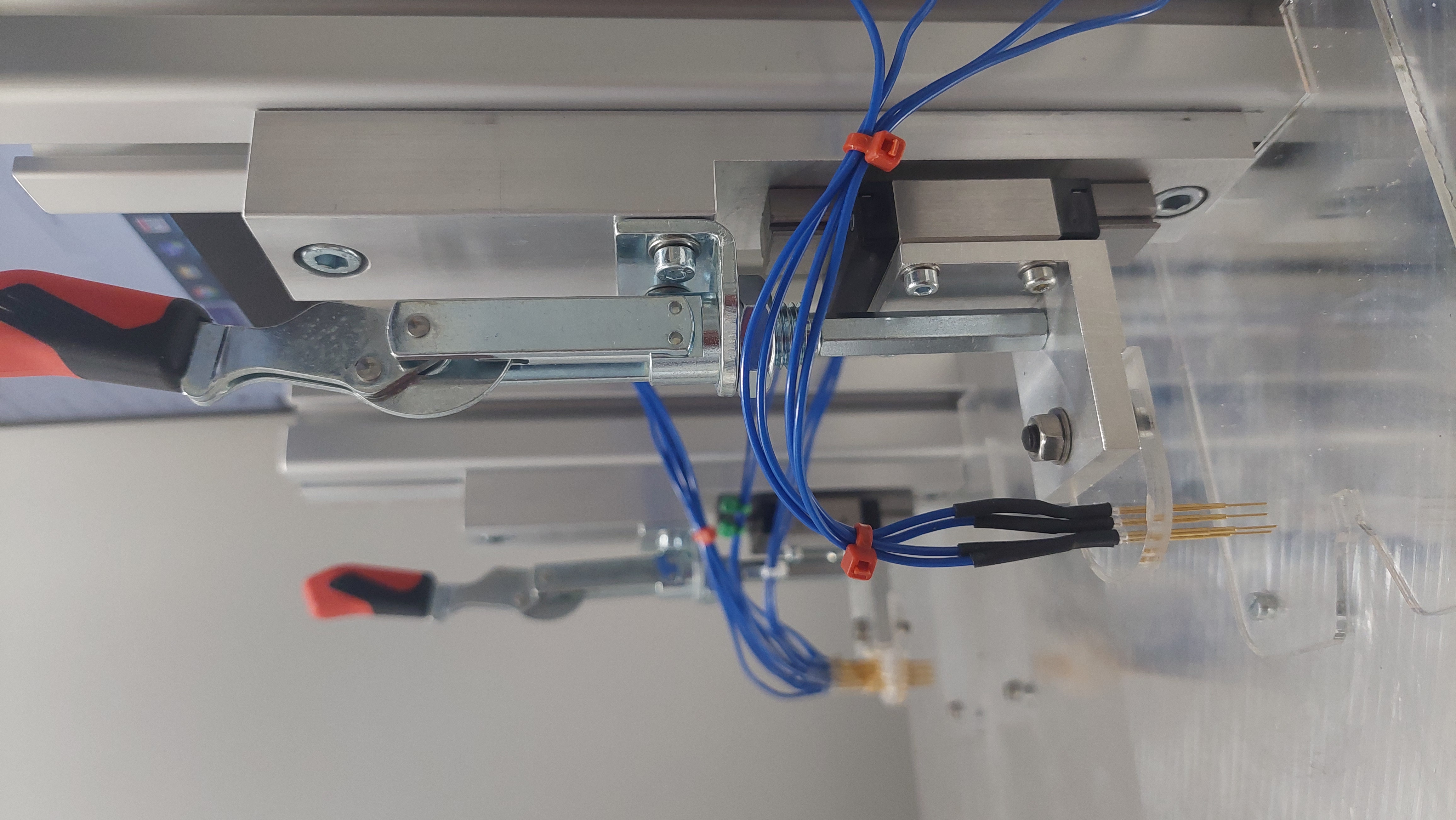 Testing and characterization of surface mount devices (SMDs) require soldering on printed circuit boards, which can result in bottlenecks when conducting through-acoustic scans for package analysis. Therefore, for research purposes, CITC has developed custom probe stations* capable of directly probing SMD packages without the need for soldering to a test board.
Testing and characterization of surface mount devices (SMDs) require soldering on printed circuit boards, which can result in bottlenecks when conducting through-acoustic scans for package analysis. Therefore, for research purposes, CITC has developed custom probe stations* capable of directly probing SMD packages without the need for soldering to a test board.
“Currently, we have two different probe stations that are designed specifically for two different SMD package types,” adds Henry. “The probes allow 4-point Kelvin contacts for accurate measurements and are connected to a dual-channel source unit and a digital multimeter. The instruments are controlled using a user-defined MATLAB program and collect the data for further processing.”
*manufactured by our partner Holst Centre
Advanced imaging techniques
To effectively analyze failures and improve packaging processes, CITC has equipment such as confocal laser microscope(s), scanning electron microscope (SEM), and scanning acoustic microscope (SAM).
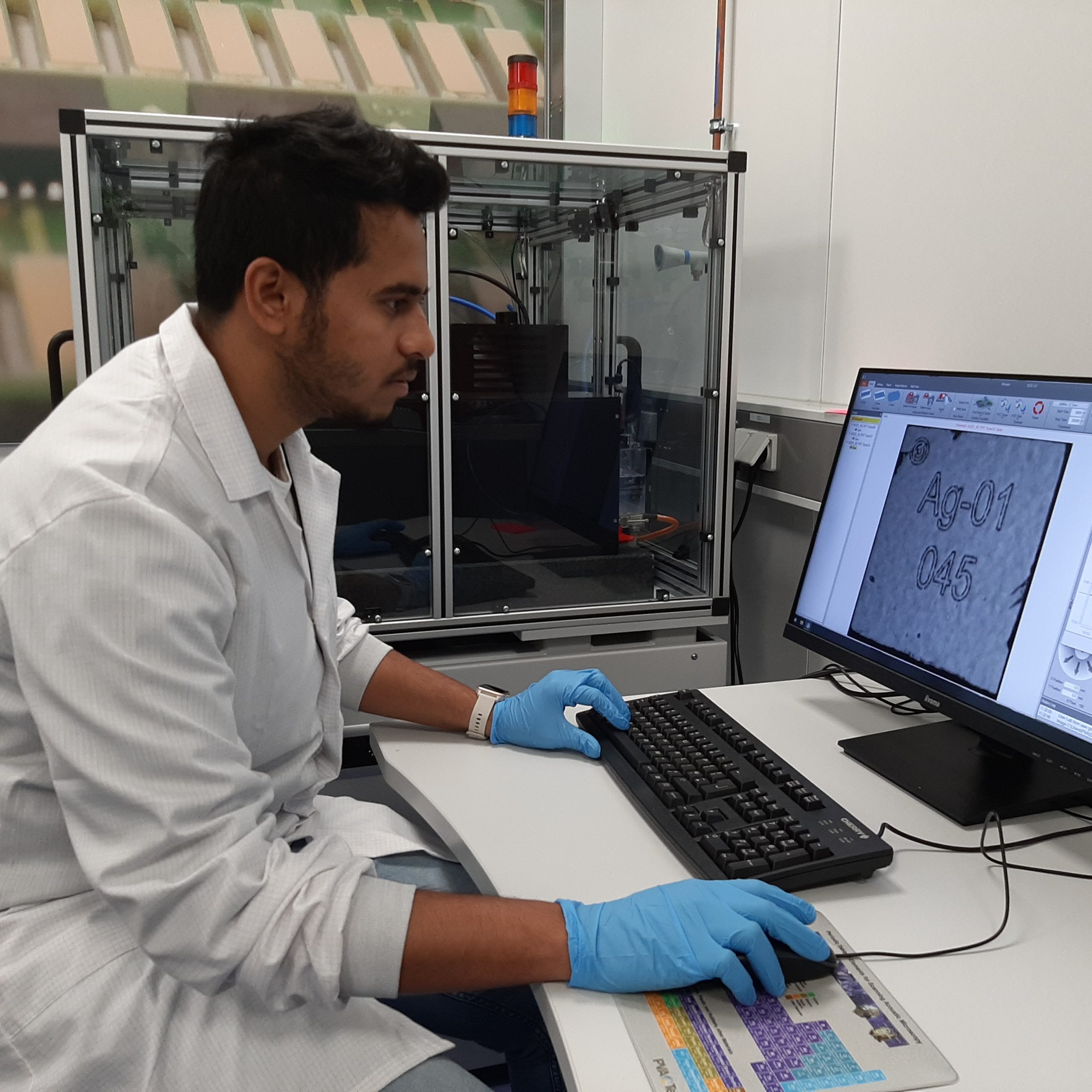 Henry has spent a lot of time working with the SAM due to its importance in package reliability analysis. He explains why he considers it so useful: “Scanning acoustic microscopy is a powerful, non-destructive method for identifying electronic packaging defects. Acoustic microscopy consists of a piezoelectric transducer that generates ultrasound pulses that are transmitted to the sample through a water medium.
Henry has spent a lot of time working with the SAM due to its importance in package reliability analysis. He explains why he considers it so useful: “Scanning acoustic microscopy is a powerful, non-destructive method for identifying electronic packaging defects. Acoustic microscopy consists of a piezoelectric transducer that generates ultrasound pulses that are transmitted to the sample through a water medium.
Water is used as a coupling medium in SAM due to its excellent ultrasonic conductivity and relatively low acoustic impedance. As the ultrasonic waves interact with material interfaces, they undergo reflection and scattering, producing an echo signal that is converted into an electrical output. An image processor then digitizes this signal. The raster scanning motion of the acoustic transducer generates ultrasonic pulses at high frequencies that are reflected from the sample, thereby capturing the depth information.”
He continues: “It is important to acknowledge that SAM, like any imaging technique, has its limitations. The penetration depth of acoustic waves typically ranges from approx. 1 mm to 2 mm for most materials and image quality is highly dependent on the properties of the sample being imaged. When designing new package types, and improving the package assembly processes, SAM is essential to understand the failure modes without any destructive methods.”
If you are interested in (one of) these reliability techniques, please contact CITC.
October 25, 2023 – The practical part of the CITC/HAN Semiconductor Packaging University Program started last week. First participants: four professors from the Universidad Tecnológica de Panamá.
Earlier this year, CITC’s education consultant Joop Bruines was invited to give a presentation in the virtual conference cycle about R&D of the Universidad Tecnológica de Panamá. As a result, several Panamanian professors and PhD students showed interest in the Semiconductor Packaging University Program.
Getting up early for online classes
Four participants joined the online theoretical part that started in September online. “It meant getting up really early for us, but it was worth it”, says Diego Bouche. “We did not know much about the semiconductor industry and now we were at least prepared for our visit here.” Together with three colleagues Diego arrived in the Netherlands for a week of practical training.
Visiting semicon companies
One of the other participants, Itamar Harris, explains the background of their visit. “The U.S. is interested in locating one or more semiconductor OSATs in Panama. We want to be well prepared and are happy to be able to take a look at the semiconductor industry in Europe.” There was plenty of opportunity for this, as Joop had arranged several visits to semiconductor companies on the Noviotech Campus. In addition to visits to ITEC and Sencio, the group was invited to NXP where they received a plant tour and visited the test program development department.
Working with backend equipment
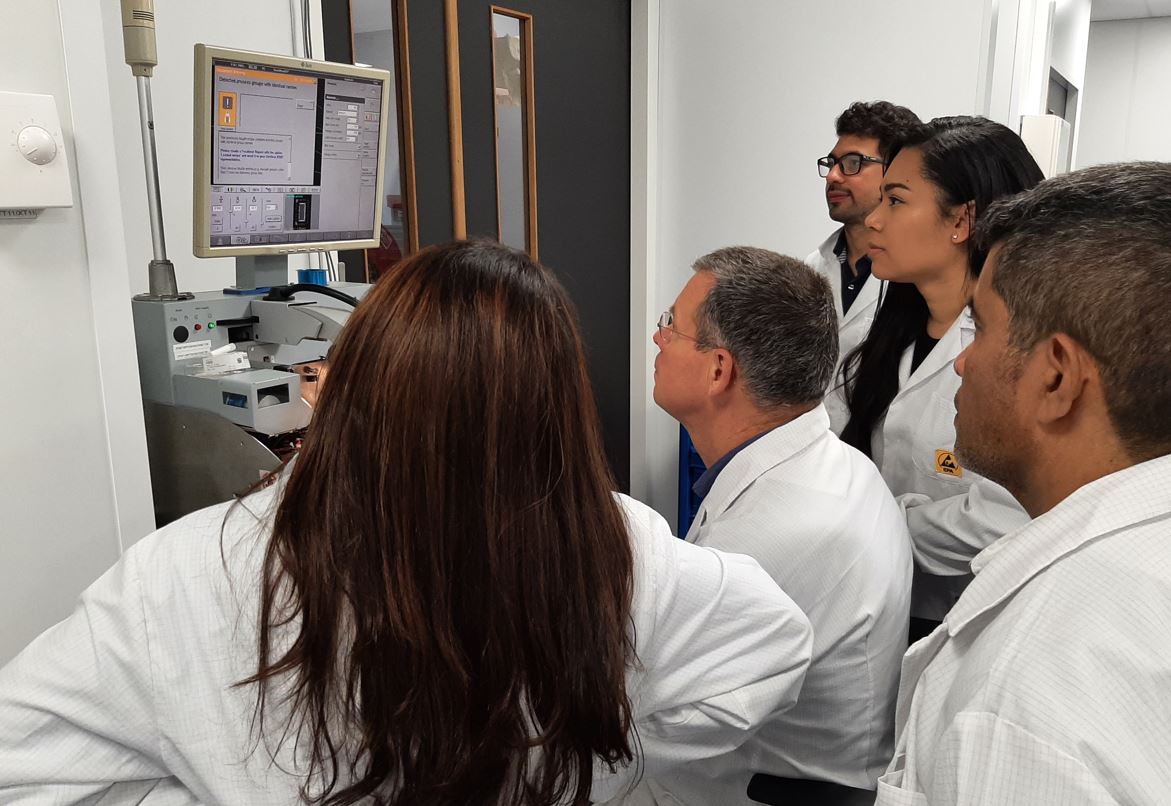 Back at CITC, the group was trained on the backend equipment in the labs. Under supervision of CITC lab manager Martien Kengen, they learned all the basic principles about typical backend activities such as die placement and wire bonding. Diego comments: “What I really liked was that we were actually allowed to work with the equipment. Wire bonding is a very challenging task, so it is good to have experienced this first-hand.”
Back at CITC, the group was trained on the backend equipment in the labs. Under supervision of CITC lab manager Martien Kengen, they learned all the basic principles about typical backend activities such as die placement and wire bonding. Diego comments: “What I really liked was that we were actually allowed to work with the equipment. Wire bonding is a very challenging task, so it is good to have experienced this first-hand.”
At the end of the week and after spending many hours in the lab, the four participants received their well-deserved certificate from Martien and Joop.
Up next…
The practical part of the CITC university program continues this week with European based participants and the students who follow the full minor program at the beginning of November. If you are interested in expanding your knowledge of semiconductor packaging, check out the university program information.
August 30, 2023 – On Monday August 28, the fourth edition of the Semiconductor Packaging University Program started at the Noviotech Campus in Nijmegen. A record 49 participants registered for this year’s edition. Over the next seven weeks, they will be introduced to the semiconductor industry and delve into the final step of chip manufacturing: chip packaging.
Mix of students and semicon staff
As in all previous editions, the participants consist of a mix of students and professionals. Joop Bruines, education consultant at CITC and also working at HAN, is happy with the full classroom: “We have a nice mix of people. In addition to industry participants from companies such as ITEC and KDPOF, there are fifteen bachelor students from HAN and similar Dutch universities of applied sciences and from Rhein-Whaal Hochschule in Cleves.”
The course also has two new types of participants. Bruines: “Up until now, our students have only been bachelor’s students. This year, however, we have a whole group of PhD candidates who have subscribed. Most of these come from the European-funded Marie Curie Anterra project on non-terrestrial communication in the telecom industry. That means that students not only come from the Netherlands but also from Sweden, Italy, and France. Most of them will take the course online.”
But that is not the only first. “Another new group of students who follow the program online comes from Panama. Four professors from Universidad Tecnológica de Panamá expressed an interest in semiconductor packaging as a whole and decided to register. They will also come to the Netherlands later this year for the practical part of the program.”
Tailor-made program
CITC and HAN University of Applied Sciences (HAN) developed this program tailored to the specific needs of semiconductor companies. The program focuses on the design and manufacture of semiconductor packages and the associated assembly, reliability, and testing techniques. For the bachelor students the course is part of a full minor including a practical assignment which is carried out at either a semiconductor company or CITC.
Kick-off
In his introductory speech at the kick-off, Bruines emphasized the importance of chips in everyday life and the need for well-trained people in this field. This was confirmed by CITC’s general manager Mark Luke Farrugia who personally welcomed the semiconductor packaging class of 2023. He was happy to meet the new generation of semiconductor staff.
After a short online welcome by Tom Spanjaard of HAN, the Noviotech Campus community manager Yvette Akkermans gave a brief overview of the campus and the ambition to create an attractive ecosystem for companies in health and high-tech. Then, Henk van Zeijl from TU Delft took over with the first lecture of the program.
Interested in following the next edition of this program? Check out the program information or contact us.
June 7, 2023 – CITC’s lab has been expanded with a confocal scanning acoustic microscope (CSAM) from acoustic microscopy expert PVA TePla. The microscope provides non-destructive quality control capabilities. It will therefore allow CITC to assess the reliability of the sinter die attachment to the leadframe.
Extensive training
Successfully determining which materials and processes are reliable for packaging is crucial to the mass commercialization of power and WBG semiconductors. Flawless basic materials are the key to flawless products. Cracks, cavities, detachment, or inclusions result in failures in the subsequent production process, which can be avoided with the help of reliable material analysis.
To realize this in our Thermal High-Performance packaging program, CITC will use the CSAM. Three of our colleagues have been extensively trained in its use. Now, the CSAM is available for our own research projects and for third parties who’d like to check the quality of their bonding technologies.
Sneak peek
You can take a sneak peek of the CSAM in this video in which Sebastien Libon, one of our researchers, gives a small demonstration.
Read more about the collaboration between CITC and PVA TePla